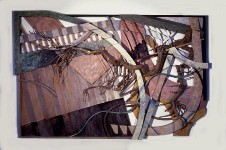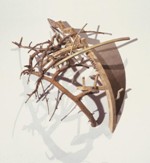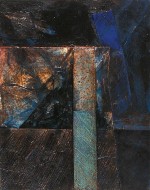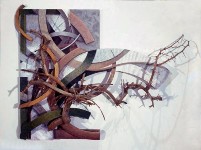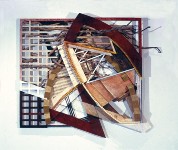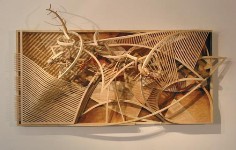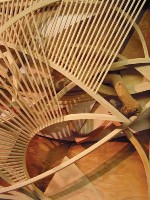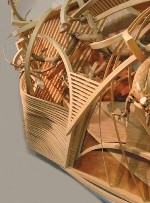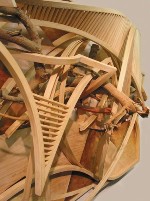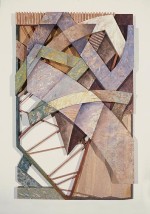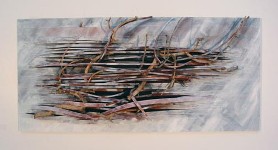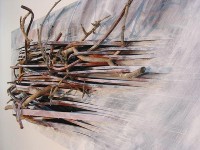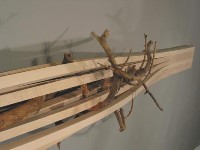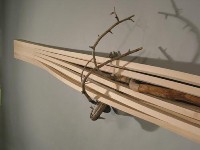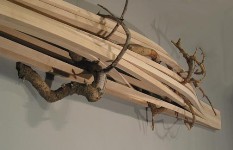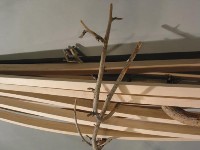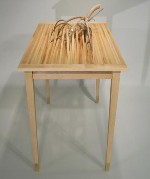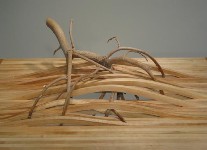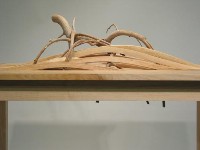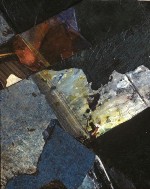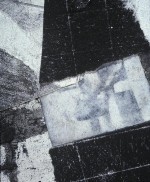Fall 2004, Volume 22.1
Art

Jim Jacobs
Context and Form: Shaping the Lines Between the Natural and the Human
Born in Philadelphia, Jim Jacobs earned a BFA at Jacksonville University in Florida, then an MFA at East Carolina University in North Carolina, where he majored in painting and minored in wood design. In 1985, he moved to Utah to teach at Weber State University, where he is currently a professor of art. His work, which has been exhibited nationally, can be seen at the Phillips Gallery in Salt Lake City.
For thousands of years, the relationship between human beings and nature has been seen as somewhat, if not entirely, one of opposition. Nature has been seen, alternately, as something to be tamed and conquered or as a resource provided by God with human beings as managers. More recently, nature has been seen as victim. While all of these perspectives have served their political purpose, it is fairly clear, as Darwin has shown, that man and nature are one. In my work, I am interested in demonstrating this singular relationship—this wholeness.
In my most recent works, such as Cocoon and Table for Darwin, maple wood, which has been processed through sawing and lamination, is combined with unaltered tree limbs. In Cocoon, whether one sees the limbs as gradually penetrating and disrupting the structured maple (like a weed through concrete) or whether the maple is seen as overtaking and strangling the mulberry limbs, both elements are essentially the same material. For me, my work becomes a metaphor for the peculiar relationship between the natural and the human.
(Click on the picture to enlarge)
My interest in sculptural paintings has grown out of my interest in the painting's relationship to its environment. Rather than treat the painting as an object, using paint to assert the physical nature of the work, or handle the surface as a transparent plane, using paint to create this illusion, I have been interested in creating an ambiguity between the painting and the environment in which it exists.
To create this ambiguity, I have used a number of approaches based on gestalt theory. Based on the principle of closure, I began to create voids in my paintings that would mimic some shapes painted on the canvas. Because of their shapes and relationships to the painted surface, these voids became visually integral parts of the painting rather than open holes through the painting.
Gradually, the paintings became more and more dimensionally complex. As the paintings grew more sculpturally intricate, I became more interested in the nature of the support upon which the canvas was stretched. Eventually, a number of paintings were wood support constructions that were painted but not covered with canvas.
The notion of contextual relationship has intrigued me for more than twenty years. In the series represented by works such as Wattle [below] and Prosthesis [opposite page], I have tried to soften the line between the painting and the wall on which it hangs. This approach can be seen in Wattle, where the wall is visible through the openings in the grid. In addition, at the bottom center of this painting, there is an opening, and an adjacent part of the painting is the same color as the wall. From a distance, it is difficult to separate the wall from the painting. My intent with these works is to blur the line between the object and the world in which it exists and to examine the idea of boundaries and interrelationships.
In Table for Darwin the idea of incorporating "processed" material is taken one step further in that the maple is not only processed but has been transformed into a table, something that would be functional, except for the negation by the natural. This relationship not only heightens the seeming distinctions between the two elements, it personifies them, creating a surreal and comical juxtaposition.
The paper pieces are generally made out of "found materials," such as scraps of paper, tarpaper, paint that has dried on the palette, and discarded photos. Rather than place the materials according to a predetermined design, the parts are layered and then gradually torn away. In this manner, the final image is discovered.

